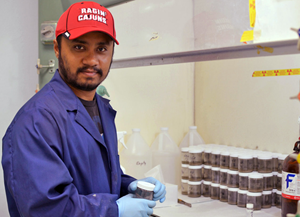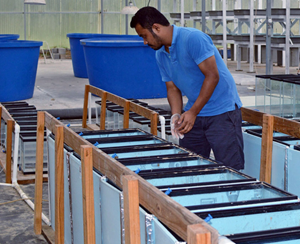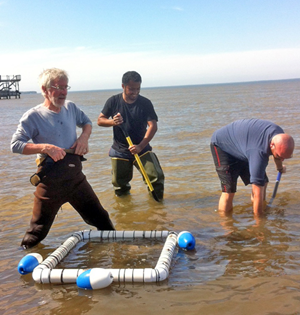
Nihar conducts a 14C-radiolabeled naphthalene assay in a radioactive laboratory to determine naphthalene degradation rate using sediments after each greenhouse microcosm experiment. (Photo credit: Suchandra Hazra)
Nihar Deb Adhikary uses his veterinary training and microbiology research to better understand the connections between oil fate, microbial degradation, and sediment-dwelling organisms such as shrimp and clams.
“Oil in coastal sediment can significantly impact the animals that live there,” he said. “I think it will be amazing if we can show that these benthic organisms help enhance oil degradation.” Nihar is an environmental and evolutionary biology Ph.D. student at the University of Louisiana at Lafayette and a GoMRI Scholar with the project The Effect of Sediment Bioturbators on the Biological Degradation of Petroleum in Coastal Ecosystems. He explains how a background in veterinary medicine led to studying oil-degrading microbes.
His Path

Nihar samples sediment and water from microcosms in the project’s greenhouse.
(Photo credit: Suchandra Hazra)
Nihar, an animal-lover, wanted to pursue biological sciences since he was in high school. He saw a veterinary career as the perfect way to practice biology and work with animals. However, while studying veterinary medicine at West Bengal University of Animal & Fishery Sciences in Kolkata, India, he became interested in conducting molecular and microbiological research. He explained, “Working with animals made me realize there are many different ways to address animal health problems.” After completing his veterinary degree, he enrolled in a masters’ program studying bacterial biofilms at Texas State University.
While conducting biofilm research, Nihar narrowed his interests to a combination of environmental science and microbiology. His opportunity came when he met Dr. Paul Klerks and his advisor Dr. Andrei Chistoserdov through the University of Louisiana at Lafayette Ph.D. program. Nihar soon began working on their GoMRI project researching the influence of bioturbators on petroleum bioremediation. He says, “While the Deepwater Horizon oil spill was a huge environmental disaster, it also presented the perfect opportunity to conduct research in environmental microbiology.”
His Work

Nihar works at the UL Lafayette Biology Department in the Chistoserdov Lab under the hooded ventilation system to quantify PAH dioxygenase gene expression. (Photo credit: Suchandra Hazra)
Nihar’s work assesses how bioturbators – organisms such as worms, shrimp, and crabs that burrow and live in sediment – affect the fate of oil by altering the physical and chemical properties of coastal marsh and beach sediment. He and his team are focusing on ghost shrimp and stout razor clams, two organisms abundant throughout the Gulf Coast. He recreates coastal sediment conditions in a greenhouse using ten-gallon (for razor clams) and thirty-gallon (for ghost shrimp) tanks filled with water and sediment. Once the shrimp and clams have acclimated to the tanks, he introduces crude oil. After ten days, his colleagues measure oil content in the water and sediment, and Nihar assesses the composition and activity of the microbial community.
Nihar observed that ghost shrimp activity increased degradation of naphthalene, the simplest polycyclic aromatic hydrocarbon. He hypothesizes that ghost shrimp’s natural functions and movement add organic matter and allow oxygen to penetrate further into the sediment, stimulating the growth of aerobic microorganisms and thereby enhancing microbial oil degradation. Increased oil exposure due to bioturbation may also stimulate oil-degrading genes in microbes. Although he found no changes in the number of oil-degrading bacteria or the microbial community at the phylum level, he has begun analyses at the genus level and is preparing to analyze 16S rDNA libraries to better understand these findings.
His Learning
While conducting his research, Nihar enjoyed working with experts from different scientific fields. He said, “Both the laboratory work and the field sampling helped me understand the value of collaboration. Reaching out to other researchers at GoMRI meetings has broadened my insights into my own project and oil spill research as a whole.” Working with Chistoserdov and Klerks is especially exciting and encouraging for Nihar, who said that the skills and experience he has gained from them will help him with future research. “I believe I am working in a great program with great people at UL – Lafayette,” he said. “It is like a small family to me, providing me with a home away from home.”
His Future

Nihar (center) collects razor clams from Choctawhatchee Bay in Defuniac Springs, Florida, with Dr. Paul Klerks (left) and fellow graduate student Alex Kascak (right). (Photo credit: Lujun Luo)
After completing his Ph.D., Nihar plans to start a career in environmental science, preferably in an environmental consulting or testing company. He is also interested in pursuing a post-doctoral position to gain more experience in his field.
Praise for Nihar
Chistoserdov described Nihar as a dedicated and inquisitive researcher whose versatility is one of his greatest strengths. He explained that Nihar feels equally at home in the field and in the laboratory. Furthermore, he is accustomed to dealing with larger animals (in their case, shrimp and clams) through his veterinary background and working with microorganisms as a trained microbiologist. Chistoserdov said these traits make Nihar an ideal researcher for their project. He explained, “Nihar’s findings were made working in close collaboration with students and faculty from our university, underscoring another of his strong points – the ability to be a productive member of a research team.”
The GoMRI community embraces bright and dedicated students like Nihar Deb Adhikary and their important contributions. The GoMRI Scholars Program recognizes graduate students whose work focuses on GoMRI-funded projects and builds community for the next generation of ocean science professionals.
Visit the Klerks Lab website to learn more about their work.
This research was made possible in part by a grant from BP/The Gulf of Mexico Research Initiative (GoMRI) to The Effect of Sediment Bioturbators on the Biological Degradation of Petroleum in Coastal Ecosystems. The GoMRI is a 10-year independent research program established to study the effect, and the potential associated impact, of hydrocarbon releases on the environment and public health, as well as to develop improved spill mitigation, oil detection, characterization and remediation technologies. An independent and academic 20-member Research Board makes the funding and research direction decisions to ensure the intellectual quality, effectiveness and academic independence of the GoMRI research. All research data, findings and publications will be made publicly available. The program was established through a $500 million financial commitment from BP. For more information, visit http://gulfresearchinitiative.org/.
